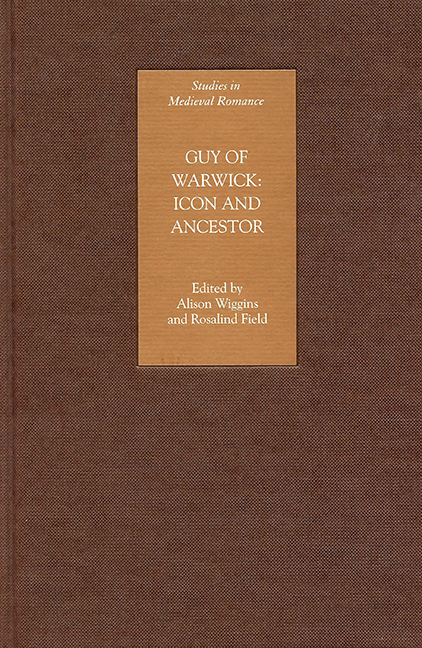Book contents
- Frontmatter
- Contents
- Illustrations
- Contributors
- Abbreviations
- Dedication
- Editorial Introduction: Namoore of this! How to read Guy of Warwick and why
- 1 Gui de Warewic at Home and Abroad: A Hero for Europe
- 2 Gui de Warewic in its Manuscript Context
- 3 Guy of Warwick as a Translation
- 4 From Gui to Guy: The Fashioning of a Popular Romance
- 5 The Manuscripts and Texts of the Middle English Guy of Warwick
- 6 The Speculum Guy de Warwick and Lydgate's Guy of Warwick: The Non-Romance Middle English Tradition
- 7 An Exemplary Life: Guy of Warwick as Medieval Culture-Hero
- 8 The Visual History of Guy of Warwick
- 9 ‘In her owne persone semly and bewteus’: Representing Women in Stories of Guy of Warwick
- 10 Of Dragons and Saracens: Guy and Bevis in Early Print Illustration
- 11 Guy of Warwick and The Faerie Queene, Book II: Chivalry Through the Ages
- 12 Guy as Early Modern English Hero
- Appendix: Synopsis of the Guy of Warwick narrative
- Index
3 - Guy of Warwick as a Translation
Published online by Cambridge University Press: 24 October 2017
- Frontmatter
- Contents
- Illustrations
- Contributors
- Abbreviations
- Dedication
- Editorial Introduction: Namoore of this! How to read Guy of Warwick and why
- 1 Gui de Warewic at Home and Abroad: A Hero for Europe
- 2 Gui de Warewic in its Manuscript Context
- 3 Guy of Warwick as a Translation
- 4 From Gui to Guy: The Fashioning of a Popular Romance
- 5 The Manuscripts and Texts of the Middle English Guy of Warwick
- 6 The Speculum Guy de Warwick and Lydgate's Guy of Warwick: The Non-Romance Middle English Tradition
- 7 An Exemplary Life: Guy of Warwick as Medieval Culture-Hero
- 8 The Visual History of Guy of Warwick
- 9 ‘In her owne persone semly and bewteus’: Representing Women in Stories of Guy of Warwick
- 10 Of Dragons and Saracens: Guy and Bevis in Early Print Illustration
- 11 Guy of Warwick and The Faerie Queene, Book II: Chivalry Through the Ages
- 12 Guy as Early Modern English Hero
- Appendix: Synopsis of the Guy of Warwick narrative
- Index
Summary
Many Middle English romances are translations of earlier Anglo-Norman or in some cases continental French narratives. While the use of the word ‘translation’ to describe some of them has been contested, few would deny that Guy of Warwick is indeed a translation, so closely does it follow its Anglo-Norman source. And yet, to say that the Middle English Guy of Warwick is a translation of the Anglo-Norman Gui de Warewic is to beg at least three questions at once. What do we mean by ‘the Middle English Guy of Warwick’? What do we mean by ‘the Anglo-Norman Gui de Warewic’? And what do we mean by ‘translation’? Let me begin by addressing this last question.
Much has been written in recent years about the nature of medieval translation. In a move that may at first sight appear paradoxical, emphasis on its uniqueness, its difference from translation as we now understand it, has made it possible to argue for the inclusion of medieval translation practices in the transhistorical category of ‘translation’. To look at Guy of Warwick as a translation can help highlight and problematize the opposite aspect of medieval translation: its frequent indistinguishability from many other medieval literary processes. In what is still the most influential study of the insular romance tradition, Susan Crane concedes that the romances of Sir Beues of Hamtoun and Guy of Warwick are ‘so closely related to Anglo-Norman versions that some critics have treated them as translations’. Yet Crane herself is reluctant to think of the different versions of such stories as products of any kind of ‘textual revision’ because ‘no English manuscript translates an extant Anglo- Norman manuscript, so that their differences cannot be considered evidence of direct poetic reworking’. Although Crane is more interested in differences between texts, whereas I will be looking for similarities, her comment pinpoints an important reason why the study of medieval translation is often a very frustrating undertaking and why, more specifically, the answers to my first two questions are not at all simple. It must be said, however, that if we cannot establish direct transmission between entire manuscripts we can do this for individual passages, sometimes of considerable length.
- Type
- Chapter
- Information
- Guy of Warwick: Icon and Ancestor , pp. 27 - 43Publisher: Boydell & BrewerPrint publication year: 2007

